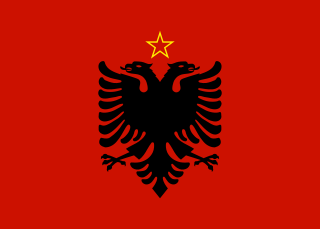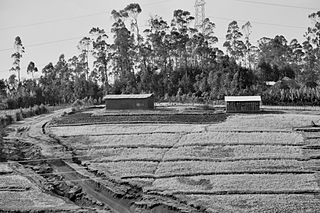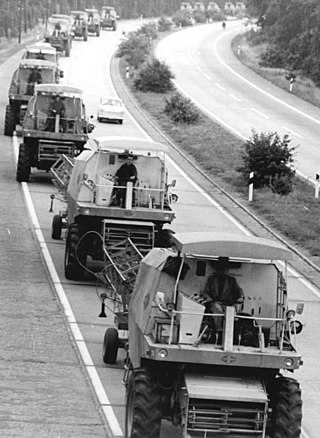Related Research Articles
Huge changes in agricultural practice were instituted under the Czechoslovak Socialist Republic. 95% of all privately owned companies were nationalized, and 95% of farms were nationalized. No one could own more than 50 hectares of land. Collectivization worked for some but not others. Larger farms were organized on 3 levels of hierarchy which actually reduced worker participation in decision making. A massive trend during the early part of the collectivization period was that younger workers left for better jobs in the cities and productivity fell. Reforms in the 1970s saw more investment and improvements began to appear gradually. There were record harvests in the 1980s.

A sovkhoz was a form of state-owned farm in the Soviet Union.

Agriculture in Russia is an important part of the economy of the Russian Federation. The agricultural sector survived a severe transition decline in the early 1990s as it struggled to transform from a command economy to a market-oriented system. Following the breakup of the Soviet Union in 1991, large collective and state farms – the backbone of Soviet agriculture – had to contend with the sudden loss of state-guaranteed marketing and supply channels and a changing legal environment that created pressure for reorganization and restructuring. In less than ten years, livestock inventories declined by half, pulling down demand for feed grains, and the area planted to grains dropped by 25%.
The agrarian reforms in Cuba sought to break up large landholdings and redistribute land to those peasants who worked it, to cooperatives, and the state. Laws relating to land reform were implemented in a series of laws passed between 1959 and 1963 after the Cuban Revolution. The Institutio Nacional de Reforma Agraria (INRA)—an agency of the Cuban government responsible to implement the first and second Agrarian Reforms. The agency adapted the Soviet model of organisation—small collectives and large(er) state farms.
In the Hungarian People's Republic, agricultural collectivization was attempted a number of times in the late 1940s, until it was finally successfully implemented in the early 1960s. By consolidating individual landowning farmers into agricultural co-operatives, the Communist government hoped to increase production and efficiency, and put agriculture under the control of the state.

The People's Socialist Republic of Albania, officially as the People's Republic of Albania from 1946 until 1976, and as the Republic of Albania from 1991 to 1992, was the communist state in Albania from 1946 to 1991. It succeeded the Democratic Government of Albania (1944–1946).
Four major land reforms have taken place in Romania: in 1864, 1921, 1945 and 1991. The first sought to undo the feudal structure that had persisted after the unification of the Danubian Principalities in 1859; the second, more drastic reform, tried to resolve lingering peasant discontent and create social harmony after the upheaval of World War I and extensive territorial expansion; the third, imposed by a mainly Communist government, did away with the remaining influence of the landed aristocracy but was itself soon undone by collectivisation, which the fourth then unravelled, leading to almost universal private ownership of land today.
Household plot is a legally defined farm type in all former socialist countries in CIS and CEE. This is a small plot of land attached to a rural residence. The household plot is primarily cultivated for subsistence and its traditional purpose since the Soviet times has been to provide the family with food. Surplus products from the household plot are sold to neighbors, relatives, and often also in farmer markets in nearby towns. The household plot was the only form of private or family farming allowed during the Soviet era, when household plots of rural people coexisted in a symbiotic relationship with large collective and state farms. Since 1990, the household plots are classified as one of the two components of the individual farm sector, the other being peasant farms – independent family farms established for commercial production on much larger areas of agricultural land, typically 10 to 50 ha. In terms of legal organization, household plots are natural (physical) persons, whereas peasant farms generally are legal (juridical) persons.

Georgia’s climate and soil have made agriculture one of its most productive economic sectors; in 1990, the 18 percent of arable Georgian land generated 32 percent of the republic's net material product in 1990. Since the end of the Soviet period, there has been a decline in the agricultural labor force: some 25 percent of the Georgian workforce was engaged in agriculture in 1990; 37 percent had been so engaged in 1970.

The problem of land reform in Ethiopia has hampered that country's economic development throughout the late 19th and 20th centuries. Attempts to modernize land ownership by giving title either to the peasants who till the soil, or to large-scale farming programs, have been tried under imperial rulers like Emperor Haile Selassie, and under Marxist regimes like the Derg, with mixed results. The present Constitution of Ethiopia, which was put into force January 1995, vests land ownership exclusively "in the State and in the peoples of Ethiopia." The relevant section continues, "Land is a common property of the Nations, Nationalities and Peoples of Ethiopia and shall not be subject to sale or to other means of exchange." Despite these different approaches to land reform, Ethiopia still faces issues of sustainable food self-sufficiency.
The Polish People's Republic pursued a policy of agricultural collectivization throughout the Stalinist regime period, from 1948 until the liberalization during Gomułka's thaw of 1956. However, Poland was the unique country in the Eastern Bloc where large-scale collectivization failed to take root. A legacy of collectivization in Poland was the network of inefficient State Agricultural Farms (PGRs), many of which can still be seen in the countryside of modern Poland, especially in its northern and western provinces.
Prior to World War II, agriculture in Bulgaria was the leading sector in the Bulgarian economy. In 1939, agriculture contributed 65 percent of Net material product (NMP), and four out of every five Bulgarians were employed in agriculture. The importance and organization of Bulgarian agriculture changed drastically after the war, however. By 1958, the Bulgarian Communist Party (BCP) had collectivized a high percentage of Bulgarian farms; in the next three decades, the state used various forms of organization to improve productivity, but none succeeded. Meanwhile, private plots remained productive and often alleviated agricultural shortages during the Todor Zhivkov era.
Despite the crisis in Syria, agriculture remains a key part of the economy. The sector still accounts for an estimated 26 percent of gross domestic product (GDP) and represents a critical safety net for the 6.7 million Syrians – including those internally displaced – who still remain in rural areas. However, agriculture and the livelihoods that depend on it have suffered massive losses . Today, food production is at a record low and around half the population remaining in Syria are unable to meet their daily food needs.

This article describes the development of agriculture in East Germany, both the Soviet occupation zone of Germany as well as the German Democratic Republic (GDR) between the years 1945 and 1990.
Agrarian reform and land reform have been a recurring theme of enormous consequence in world history. They are often highly political and have been achieved in many countries.

Collective farming and communal farming are various types of "agricultural production in which multiple farmers run their holdings as a joint enterprise". There are two broad types of communal farms: agricultural cooperatives, in which member-owners jointly engage in farming activities as a collective; and state farms, which are owned and directly run by a centralized government. The process by which farmland is aggregated is called collectivization. In some countries, there have been both state-run and cooperative-run variants. For example, the Soviet Union had both kolkhozy and sovkhozy.

A kolkhoz was a form of collective farm in the Soviet Union. Kolkhozes existed along with state farms or sovkhoz. These were the two components of the socialized farm sector that began to emerge in Soviet agriculture after the October Revolution of 1917, as an antithesis both to the feudal structure of impoverished serfdom and aristocratic landlords and to individual or family farming.
Agrarian socialism is a political ideology that promotes social ownership of agrarian and agricultural production as opposed to private ownership. Agrarian socialism involves equally distributing agricultural land among collectivized peasant villages. Many agrarian socialist movements have tended to be rural, locally focused, and traditional. Governments and political parties seeking agrarian socialist policies have existed throughout the world, in regions including Europe, Asia, North America, Latin America, and Africa.
Land reform in Vietnam began in the political turmoil following World War II in which a civil war pitted the communist Viet Minh against the French colonists and their supporters. At that time a large percentage of agricultural land was owned by large landowners and the majority of the rural population of Vietnam owned only small plots of land or was landless. The early success of the land reform program of the Viet Minh, gave the communists a strong base of support among the 80 percent of the Vietnamese people who lived in rural areas. The support of the communists by a large number of rural dwellers was an important factor in determining the outcome of the Vietnam War.

Agriculture in North Macedonia provides a livelihood for a fifth of the country's population, where half live in a rural area. Industrialisation of the country was very delayed, due to the long Ottoman domination, and then destruction from World War I and Serbian occupation. Massive agrarian reforms began under Socialist Federative Yugoslavia with its own communist rule. The continental and sub-Mediterranean climates in the country allows for a great diversity of output, but the pronounced terrain creates areas that are unexploitable for farmers. Macedonian agriculture is dominated by livestock farming, especially in its mountainous regions, viticulture, and the growing of fruit and vegetables, cereals, and tobacco. Agriculture in the country is characterised by numerous small-scale family farms, but also by large businesses, left over from the socialist era. Since its independence in 1991, the country has become a market economy. Today, agriculture accounts for 10% of North Macedonia's GDP.